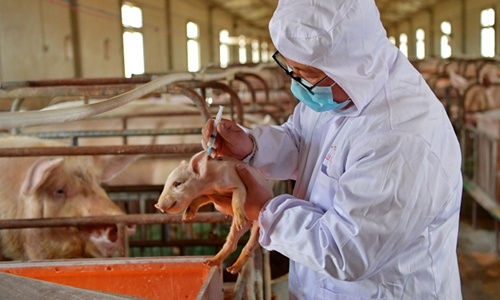
An owner of a hog farm in Qiongjie county, Shannan, Tibet autonomous region, vaccinates a piglet on April 21, 2020. (Photo: Xinhua)
Chinese legislators and political advisors have called for a higher level of self-sufficiency in seed supply and the improved breeding of livestock and poultry to reduce the risk of supply cuts, given the current reliance on foreign countries.
Li Yuncai, a member of the National Committee of the Chinese People's Political Consultative Conference (CPPCC) and inspector of the Hunan Supply and Marketing Cooperative Association, called for the seed industry's development to be a major strategy for the safe and high-quality overall development of China's agriculture, and suggested that China needs to draw up a development plan for the seed sector.
Zhao Wanping, a deputy to the National People's Congress (NPC) and the vice head of the Anhui Academy of Agricultural Sciences, pointed out that the core species sources that underpin China's production of pork, chicken, eggs and milk are heavily dependent on imports from the US and Canada. Amid intensified China-US strategic competition, cutting supplies would harm China.
Minister of Agriculture and Rural Affairs Tang Renjian said in January that seeds are the key to China's food security.
He stressed that efforts should be concentrated on resource protection and independent innovation, so as to narrow the gaps between corn, soybeans and pig breeds with international advanced levels, and ensure that the provenance of important agricultural products is independent and controllable.
"Grain such as soybean depends highly on import and corn import increases dramatically too. High-end varieties of vegetable seeds are mainly imported… The germplasm resources of livestock and poultry have depended on foreign imports for a long time," LüYuping, general manager of Longping Biotechnology (Hainan) Co, told the Global Times on Wednesday.
According to Lü, the stranglehold problem regarding seed and breeding resources, or the "chips of agriculture," refers to disadvantages in germplasm resources and sophisticated technologies including transgenic traits and crop gene editing.
China's corn and soybean production is only about half that of the US, as nearly 100 percent of the corn and soybeans grown in the US are genetically modified, while China does not currently grow genetically modified soybeans and corn, Lü said.
Core genetic traits are in the hands of industry giants such as Bayer, Kodiva and Syngenta. Just as mobile phone manufacturers pay Qualcomm patent licensing fees, breeders also pay high trait licensing fees to use those genetic traits.
China's germplasm resources are mainly from native species, which are easily outcompeted by modified breeds that have special traits.
As to local varieties of grain in China, there were 11,590 in 1956 but only 3,271 in 2014, and the loss rate of major local varieties of grain crops is as high as 71.8 percent, the Xinhua News Agency reported in 2018.
China's most recent survey of livestock and poultry genetic resources was conducted more than 15 years ago by then Ministry of Agriculture. The results showed that of 125 pig breeds in China, 88 were local, and 85 percent of the local pig breeds were declining in numbers. Some 31 local breeds were endangered and at least four were extinct.
Guo Huiyong, an independent analyst of the animal husbandry industry, told the Global Times on Wednesday that China imports an average of 20,000 foreign breeding pigs every year, and 70 percent of the pork on the market comes from foreign breeds or improved varieties of foreign breeds.
Local unmodified pigs are more resistant to diseases but less popular in the market because their meat contains more fat. Breeds from the US, France and Denmark grow faster and have more lean meat, Guo said.
However, local pigs have some favorable traits such as the Taihu breed, which can have more than 20 piglets in one litter, said Guo. "Many foreign pigs have adopted the genes of Taihu pigs, but we have not made good use of them ourselves."
China also needs to catch up in some core technologies and equipment in biotechnologies, observers said, noting that the gene-editing patents are mostly mastered by US companies.
Monsanto's annual investment in seed gene research and development is equal to China's total gene modification inputs in the past 12 years. Chinese enterprises should improve transgenic technology and make long-term investments, Lü said.
Breeding takes a lot of work and money before yielding profits, and the process may take decades, so most companies are unwilling to do so, Guo said.
China is building a new national crop germplasm bank, which will be ready for use this year, with a designed storage capacity of 1.5 million samples, nearly four times that of the existing germplasm banks and ranking first in the world, media reported.


